
The Empire of Brazil was a 19th-century state that broadly comprised the territories which form modern Brazil and Uruguay. Its government was a representative parliamentary constitutional monarchy under the rule of Emperors Pedro I and his son Pedro II. A colony of the Kingdom of Portugal, Brazil became the seat of the Portuguese Empire in 1808, when the Portuguese Prince regent, later King Dom John VI, fled from Napoleon's invasion of Portugal and established himself and his government in the Brazilian city of Rio de Janeiro. John VI later returned to Portugal, leaving his eldest son and heir-apparent, Pedro, to rule the Kingdom of Brazil as regent. On 7 September 1822, Pedro declared the independence of Brazil and, after waging a successful war against his father's kingdom, was acclaimed on 12 October as Pedro I, the first Emperor of Brazil. The new country was huge, sparsely populated and ethnically diverse.
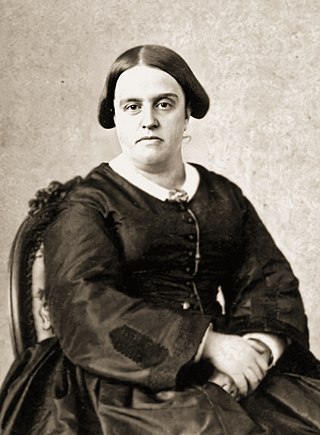
Princess Januária of Brazil was a Brazilian princess and Portuguese infanta (princess). She was the second daughter of Pedro I of Brazil and IV of Portugal and his first wife, Archduchess Maria Leopoldina of Austria.

Luís Alves de Lima e Silva, Duke of Caxias, nicknamed "the Peacemaker" and "the Iron Duke", was an army officer, politician and monarchist of the Empire of Brazil. Like his father and uncles, Caxias pursued a military career. In 1823 he fought as a young officer in the Brazilian War for Independence against Portugal, then spent three years in Brazil's southernmost province, Cisplatina, as the government unsuccessfully resisted that province's secession in the Cisplatine War. Though his own father and uncles renounced Emperor Dom Pedro I during the protests of 1831, Caxias remained loyal. Pedro I abdicated in favor of his young son Dom Pedro II, whom Caxias instructed in swordsmanship and horsemanship and eventually befriended.

Água Preta is a Brazilian municipality (city) in the state of Pernambuco. It covers 533.33 km2 (205.92 sq mi), and has a population of 37,082 with a population density of 62.05 inhabitants per square kilometer.
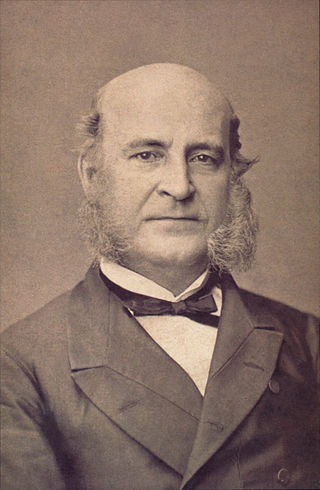
José Maria da Silva Paranhos, Viscount of Rio Branco, was a Brazilian politician, monarchist, diplomat, teacher and journalist. Rio Branco was born in Salvador, in what was then the Captaincy of Bahia, to a wealthy family, but most of the fortune was lost after his parents' deaths early in his childhood. In 1871, Rio Branco became the President of the Council of Ministers for the first time. He would become the Council's longest-serving president, and his cabinet the second longest, in Brazilian history. His government was marked by a time of economic prosperity and the enactment of several reforms. The most important of these initiatives was the Law of Free Birth, which granted freeborn status to children born to slave women. Rio Branco led the government that enacted this law, and its passage increased his popularity. His government was plagued by a long crisis with the Catholic Church that resulted from the expulsion of Freemasons from its lay brotherhoods. After more than four years heading the Cabinet, Rio Branco resigned in 1875. Following a long vacation in Europe, his health swiftly declined and he was diagnosed with oral cancer. Rio Branco died in 1880 and was widely mourned throughout the country. He is regarded by most historians as one of Brazil's greatest statesmen.

The Imperial Order of Our Lord Jesus Christ, simply named Order of Christ, is an order of chivalry instituted by emperor Pedro I of Brazil on 7 December 1822, on the basis of the Portuguese Order of Christ founded by King Dom Dinis and Pope John XXII in 1316–1319.

Dom Afonso was the Prince Imperial and heir apparent to the throne of the Empire of Brazil. Born in Rio de Janeiro, he was the eldest child of Emperor Dom Pedro II and Dona Teresa Cristina of the Two Sicilies, and thus a member of the Brazilian branch of the House of Braganza.

The Armed Forces of the Empire of Brazil were the overall unified military forces of the Empire of Brazil. The Brazilian military was first formed by Emperor Dom Pedro I to defend the new nation against the Portuguese in the Brazilian War of Independence. The Army and Armada were commissioned in 1822 with the objective of defeating and expelling the Portuguese troops from Brazilian soil.
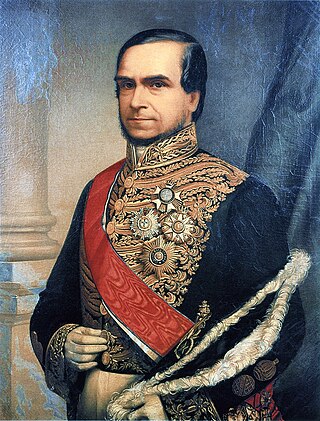
Honório Hermeto Carneiro Leão, Marquis of Paraná was a politician, diplomat, judge and monarchist of the Empire of Brazil. Paraná was born to a family of humble means in São Carlos do Jacuí, in what was then the captaincy of Minas Gerais. After attending the University of Coimbra in Portugal and having returned to Brazil, Paraná was appointed a judge in 1826 and later elevated to appellate court justice. In 1830, he was elected to represent Minas Gerais in the Chamber of Deputies; he was re-elected in 1834 and 1838, and held the post until 1841.

Pedro de Araújo Lima, Marquis of Olinda was a politician and monarchist of the Empire of Brazil. His long political career spanned the reigns of John VI, Pedro I and Pedro II. He was also one of the founders of the Brazilian Conservative Party.

The early life of Pedro II of Brazil covers the period from his birth on 2 December 1825 until 18 July 1841, when he was crowned and consecrated. Born in Rio de Janeiro, the Brazilian Emperor Dom Pedro II was the youngest and only surviving male child of Dom Pedro I, first emperor of Brazil, and his wife Dona Leopoldina, archduchess of Austria. From birth, he was heir to his father's throne and was styled Prince Imperial. As member of the Brazilian Royalty, he held the honorific title "Dom".

Dom Pedro Afonso was the Prince Imperial and heir apparent to the throne of the Empire of Brazil. Born at the Palace of São Cristóvão in Rio de Janeiro, he was the second son and youngest child of Emperor Dom Pedro II and Dona Teresa Cristina of the Two Sicilies, and thus a member of the Brazilian branch of the House of Braganza. Pedro Afonso was seen as vital to the future viability of the monarchy, which had been put in jeopardy by the death of his older brother Dom Afonso almost three years earlier.

The Cabanada or War of Cabanos was a rebellion that occurred in the Empire of Brazil between 1832 and 1835. it started shortly after the abdication of Dom Pedro I, during the regency period.

The April Revolt, or Abrilada in Brazil's history was an episode in 1832 in the then province of Pernambuco, which fits into the Regency Period, in the context of Cabanagem. After the abdication of D. Pedro I of Brazil and his return to Europe where he played a decisive role in the Portuguese Civil War (1828–1834), the movement in Pernambuco, a conservative and absolutist, aimed at the renewal of D. Pedro I to the throne.
The 1868 Brazilian political crisis led to the resignation of the ruling Progressive cabinet and the return of the Conservative Party to power in the Empire of Brazil.

The Liberal Rebellions of 1842 were a series of rebellions that took place in the Brazilian provinces of Minas Gerais and São Paulo in response to actions taken by emperor Dom Pedro II to unify power under the central government and limit the powers of the provinces. These rebellions were poorly coordinated and were put down by the central government to little effect. Along with the rebellions in Rio Grande do Sul, the Liberal Rebellions marked the end of a series of province-level rebellions that threatened the Empire of Brazil's stability.
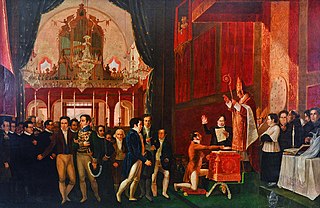
The regency period is how the decade from 1831 to 1840 became known in the history of the Empire of Brazil, between the abdication of Emperor Pedro I, on 7 April 1831, and the declaration of age of Pedro II, who was legally declared of age by the Senate at the age of 14 on 23 July 1840.
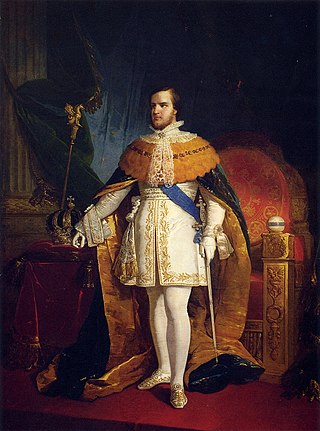
The Second Reign is a period of history within the Empire of Brazil that lasted 49 years, beginning with the end of the regency period on 23 July 1840, upon the declaration of Pedro de Alcântara's majority, and ending on 15 November 1889, when the parliamentary constitutional monarchy in force was removed by the proclamation of the republic.

The Declaration of age of Pedro II, also referred to as the Majority Coup in Brazilian history, happened on July 23, 1840, with the support of the Liberal Party and put an end to the Brazilian Regency period. The liberals mobilized the people, who pressured the Senate to declare Pedro II of legal age before he turned 15. In 1834, the Portuguese Parliament had already declared the age of majority for Maria II, Pedro II's sister, who became queen without a regent.
















